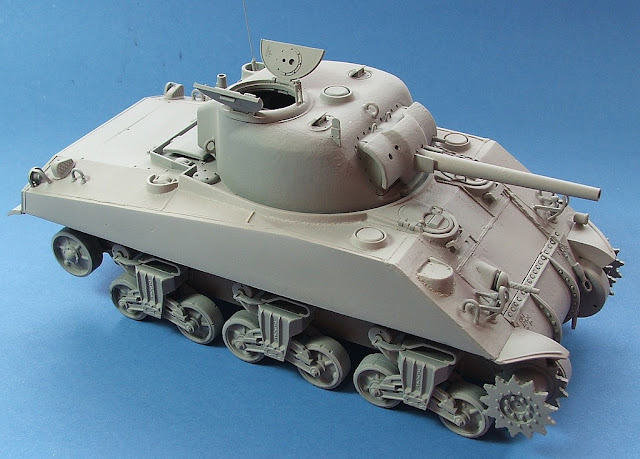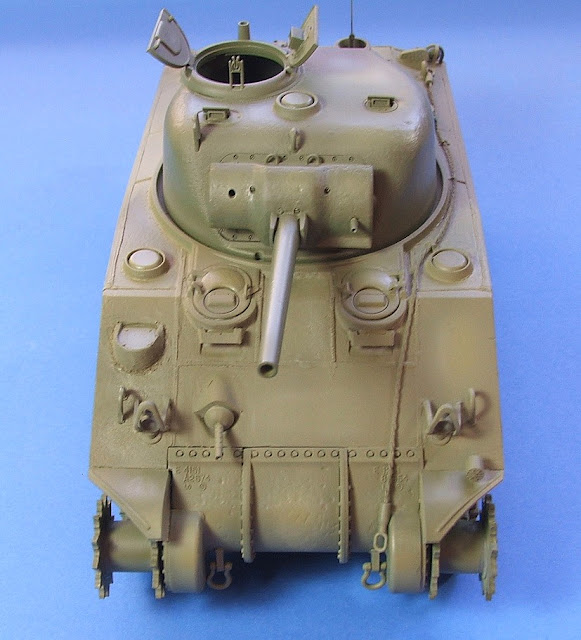Tankers!!
Finally lets see one the most emblematic of Allied tanks, the Sherman M4 medium tank. The objective of this report is to know the early version of this brave tank, with direct vision slots.
 |
| M4 Sherman tanks (DV) at Anzio - Italy 27 April, 1944 |
History:
The M4 Sherman, officially Medium Tank, M4, was the most numerous battle tank used by the United States and some other Western Allies in World War II. It proved to be reliable and mobile. In spite of being outclassed by German medium and heavy tanks late in the war, the M4 Sherman was cheaper to produce and available in greater numbers.
 |
| M4 Sherman tank covering men of US 60th Infantry Regiment, Belgium, 9 Sep 1944 |
Thousands were distributed through the Lend-Lease program to the British Commonwealth and Soviet Union. The tank was named after the American Civil War General William Tecumseh Sherman by the British.
 |
| British Sherman tank of XIII Corps, Eighth Army in the streets of Francofonte, Sicily, 13-14 Jul 1943 |
The M4 Sherman evolved from the interim M3 Medium Tank which had its main armament in a side sponson mount. The M4 retained much of the previous mechanical design but put the main 75 mm gun in a fully traversing turret. One controversial feature, a one-axis gyrostabilizer was not precise enough to allow firing when moving but did help keep the reticle on-target, so that when the tank did stop to fire, the gun would be aimed in roughly the right direction.
The designers stressed mechanical reliability, ease of production and maintenance, durability, standardization of parts and ammunition in a limited number of variants, and moderate size and weight. These factors combined with M4 Sherman's then-superior armor and armament outclassed German light and medium tanks of 1939-41. The M4 went on to be produced in large numbers. It spearheaded many offensives by the Western Allies after 1942.
The designers stressed mechanical reliability, ease of production and maintenance, durability, standardization of parts and ammunition in a limited number of variants, and moderate size and weight. These factors combined with M4 Sherman's then-superior armor and armament outclassed German light and medium tanks of 1939-41. The M4 went on to be produced in large numbers. It spearheaded many offensives by the Western Allies after 1942.
 |
| Crew of M4A1 Sherman tank 'Eternity' (DV) checking the tank after landing at Red Beach 2, Sicily, 10 Jul 1943 |
When the M4 tank arrived in North Africa in 1942, it was superior to the lighter German long-barrel 50 mm-gunned Panzer III and short-barrel 75 mm-gunned Panzer IV. For this reason, the US Army believed the M4 would be adequate to win the war, and no pressure was exerted for further tank development. Logistical and transport restrictions, such as limitations imposed by roads, ports, and bridges, also complicated the introduction of a more capable but heavier tank.
Tank destroyer battalions using vehicles built on the M4 hull and chassis, but with open-topped turrets and more potent high-velocity guns, also entered widespread use in the American army. Even by 1944, most M4 Shermans kept their dual purpose 75 mm M3. By 1944 and 1945, the M4 was inferior to German heavy tanks but was able to fight on with support from growing numbers of fighter-bombers and artillery pieces.
 |
| M4 Sherman DV - Notice the VVSS heavy duty suspension, 3 piece front transmission cover and direct vision slots Rome, April, 1944. |
The relative ease of production allowed huge numbers of the M4 to be manufactured, and significant investment in tank recovery and repair units allowed disabled vehicles being repaired and returned to service. These factors combined to give the Americans numerical superiority in most battles.
The direct-vision version:
In early M4 series production tanks, the driver and assistant driver (MG hull gunner) had emergency direct vision slots protected by armored flaps.
Due to production tolerances, which resulted in very small gaps between the hull and the direct-vision armored flaps hinges, firing tests demonstrated that bullet splash could enter the front hull compartment and cause serious injury to the driver and assistant driver.
 |
| A very easy explanation about the differences between the DV and Periscope glacis as published in Armorama, in 2009. |
To overcome the bullet splash problem, the Ordnance Department originally decided to weld 3/8-inch steel armored plates to the inside of the hull-around the handles used for opening the armored flaps that covered the direct-vision slots. However, with a subsequent 2-inch-long increase of the driver and assistant driver's hatch periscope mounts, it proved almost impossible for them to make use of the direct-vision slots.
The Ordnance Department then took the next logical step and dropped the direct-vision slots from the M4 series design. In their place appeared a set of fixed over-head auxiliary periscopes directly in front of the hatch periscopes.
Their inclusion also eliminated the ballistics weak spot presented by the direct-vision slots in the tank's front hull.
With the non-use of direct-vision slots, so emergency measures taken to strengthen the hulls ever built, how to weld armored covers directly over the slots and apply additional armor plates on the slots.
 |
| The DV cover welded in the slots (left) and additional armor plate (right) font: Sherman Minutia |
The Ordnance Department then took the next logical step and dropped the direct-vision slots from the M4 series design. In their place appeared a set of fixed over-head auxiliary periscopes directly in front of the hatch periscopes.
 |
| font: Sherman Minutia |
M4 Sherman Production:
| Designation | Manufacture | Total | Date |
|---|---|---|---|
| M4 | Pressed Steel Car Company Baldwin Locomotive Works American Locomotive Co. Pullman-Standard Car Company Detroit Tank Arsenal | 6,784 | July 1942 – January 1944 |
| M4(105) | Detroit Tank Arsenal | 800 | February 1944 – March 1945 |
| M4A1 | Lima Locomotive Works Pressed Steel Car Company Pacific Car and Foundry Company | 6,281 | February 1942 – December 1943 |
| M4A1(76)W | Pressed Steel Car Company | 3,246 | January 1944 – July 1945 |
| M4A2 | Fisher Tank Arsenal Pullman-Standard Car Company American Locomotive Co. Baldwin Locomotive Works Federal Machine and Welder Co. | 8,053 | April 1942 – May 1944 |
| M4A2(76)W | Fisher Tank Arsenal Pressed Steel Car Company | 2,915 | April 1944 – May 1945 |
| M4A3 | Ford Motor Company | 1,690 | June 1942 – September 1943 |
| M4A3(105) | Detroit Tank Arsenal | 500 | May 1944 – June 1945 |
| M4A3(75)W | Fisher Tank Arsenal | 3,071 | February 1944 – March 1945 |
| M4A3(76)W | Fisher Tank Arsenal Detroit Tank Arsenal | 9,924 | March 1944 – April 1945 |
| M4A3E2 | Fisher Tank Arsenal | 254 | June 1944 – July 1944 |
| M4A3E8 (76) | Detroit Tank Arsenal Fisher Tank Arsenal | 3,142 | August 1944 |
| M4A3E8 (105) | Detroit Tank Arsenal | 2,539 | September 1944 |
| M4A4 | Detroit Tank Arsenal | 7,499 | July 1942 – November 1943 |
| M4A6 | Detroit Tank Arsenal | 75 | October 1943 – February 1944 |
Specs:
| Medium Tank, M4 | |
|---|---|
| Type | Medium tank |
| Place of origin | United States |
| Service history | |
| In service | 1942–1957 (United States) |
| Used by | United States and many others |
| Production history | |
| Designer | U.S. Army Ordnance Department |
| Designed | 1940 |
| Manufacturer | |
| Produced | September 1941 (prototype) February 1942 – July 1945 |
| No. built | 49,234, excluding prototype |
| Variants | See U.S. variants and foreign variants |
| Specifications | |
| Mass | 30.3 - 38.1 ton dep. variant |
| Length | 5.84 - 6.27m dep. variant |
| Width | 2.62m - 3.00m dep. variant |
| Height | 2.74 - 2.97m dep. variant |
| Crew | 5 (commander, gunner, loader, driver, assistant driver/bow gunner) |
| Armor | 12.7 to 177.8mm dep. on location and variant |
Main armament | 75mm gun M3 (90–104 rds) or 76mm gun M1A1, M1A1C, or M1A2 (71 rds) or 105mm howitzer M4 (66 rounds) |
Secondary armament | .50 Browning M2HB machine gun (300–600 rds), 2×.30 Browning M1919A4 machine guns (6,000–6,750 rds) |
| Engine | M4 and M4A1 model: Continental R975-C1 or -C4 9 cylinder radial gasoline 350 or 400 hp @ 2,400 rpm M4A2 model: General Motors 6046 twin inline diesel; 375 hp at 2,100 rpm M4A3 model: Ford GAA V8 gasoline; 450 hp at 2,600 rpm M4A4 model: Chrysler A57 multibank gasoline; 370 hp at 2,400 rpm 9 cylinder radial diesel engine; 450 hp at 2,400 rpm |
| Power/weight | 10.5–13.5 hp/ton |
| Transmission | Spicer manual synchromesh trans., 5 forward and 1 reverse gears |
| Suspension | Vertical volute spring suspension (VVSS) or horizontal volute spring suspension (HVSS) |
| Fuel capacity | 520–660 liters |
Operational range | 160–240 km on road |
| Maximum speed | 35–48 km/h on road |
The kits:
For this project, I used two olds kits stocked in my catacomb of kits: a M4 Sherman Tamiya #35190 and a TWS M4 Early welded Sherman hull #350076 resin conversion kit:
 |
M4 Sherman Tamiya #35190
|
 |
 |
| The Tamiya chassis... |
...and the TWS upper hull.I decided to make some modifications in the upper hull: I´ll change the pattern of weld lines (green arrow) and modify the antenna base to the Pullman Standard for Baldwin (red) and and removing the rim of the machine gun cover (blue). See below:
 |
| surgeries in the hull |
 |
| Using Tamiya parts in the TWS upper hull... The plasticard strips will be the future welding lines |
 |
| Making welding markings with soldering iron |
 |
| Done.. |
 |
Adding lifting rings in the mantlet (red) and
removing the mortar aperture in the turret (green)
|
 |
Metal gun barrel from RB Models.(#35B03)
|
Now, colors and markings:
Primer...
And Olive drab:
And Olive drab:
 |
| Tonal variations on the base color ... |
 |
| Tamiya decal HURRICANE becoming ERICA |
 |
| Decals with Future (or Pledge) |
 |
| Clay made with pigment and gypsum (testing...) |
 |
| M4 Sherman medium tank - DV (early) ERICA 751st Tank Battalion, supporting 3rd Infantry Division Company HQ tank - Anzio, Italy, 1944. |
 |
M4 Sherman medium tank - DV (early) ERICA 751st Tank Battalion, supporting 3rd Infantry Division Company HQ tank - Anzio, Italy, 1944.
|
 |
| M4 Sherman medium tank - DV (early) - left side |
 |
| M4 Sherman medium tank - DV (early) - right side |
 |
| M4 Sherman medium tank - DV (early) ERICA 751st Tank Battalion, supporting 3rd Infantry Division Company HQ tank Anzio, Italy, 1944. |
Stay tuned on our Bunker !!!






























Hi Marcos. Again a very nice kit and a very good job on this Sherman but I have a little question : where are Kojak and Rover ???
ResponderExcluirHi, Alain...I´m in vacation, in Spain...and I am publishing old cases in the Bunker.
ResponderExcluirAt this time, Kojak was in "plastic surgery" ... and Rover had not yet arrived.
As soon as I return to workbench, Kojak and Rover reappear ...
Big hug, my friend !!!
Love the site Marcos!
ResponderExcluirI'm adding you to my links!